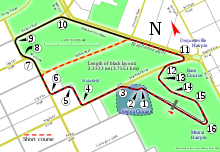| 1993 Australian Grand Prix | |||||
|---|---|---|---|---|---|
Race 16 of 16 in the 1993 Formula One World Championship
| |||||
 | |||||
| Race details | |||||
| Date | 7 November 1993 | ||||
| Location |
Adelaide Street Circuit Adelaide, South Australia, Australia | ||||
| Course | Temporary street circuit | ||||
| Course length | 3.780 km (2.362 miles) | ||||
| Distance | 79 laps, 298.620 km (186.598 miles) | ||||
| Scheduled distance | 81 laps, 306.180 km (191.322 miles) | ||||
| Weather | Sunny | ||||
| Pole position | |||||
| Driver | McLaren-Ford | ||||
| Time | 1:13.371 | ||||
| Fastest lap | |||||
| Driver |
| Williams-Renault | |||
| Time | 1:15.381 on lap 64 | ||||
| Podium | |||||
| First | McLaren-Ford | ||||
| Second | Williams-Renault | ||||
| Third | Williams-Renault | ||||
|
Lap leaders | |||||
The 1993 Australian Grand Prix was a Formula One motor race held at Adelaide on 7 November 1993. It was the sixteenth and final race of the 1993 Formula One World Championship.
The 79-lap race was won by Brazilian Ayrton Senna, driving a McLaren-Ford. In his last race with McLaren before joining Williams for 1994, Senna took pole position and led from start to finish, except during the pit stops. Frenchman Alain Prost, in his final Grand Prix before retirement, finished second in his Williams-Renault, with his British teammate Damon Hill third.
Riccardo Patrese and Derek Warwick also retired from F1 after this race, Patrese having competed in a then-record 256 Grands Prix. Senna's victory would turn out to be the 41st and last victory in his Formula One career, and the last time he would finish on the podium, score points, or even finish a race, since the following season he retired in Interlagos and Aida and died at Imola. It was also the last win for a Brazilian driver until Rubens Barrichello at the 2000 German Grand Prix.
This event was also the last race without refuelling during races (until the 2010 Bahrain Grand Prix) as well as the last race for cars with active suspension and cars using electronic driver aids; the FIA banned their use for the next seven seasons, starting in 1994, until the use of three electronic driver aid systems (namely fully-automatic gearboxes, launch control, and traction control) was eventually reintroduced and permitted at the 2001 Spanish Grand Prix, due to the FIA being unable to police the ban, and whether or not teams were secretly cheating by using these systems illegally to gain a competitive advantage, which is what led to their eventual reintroduction until the next six seasons.
By winning this race McLaren surpassed Ferrari as the most successful F1 constructor in number of wins (until the 1995 Canadian Grand Prix). McLaren achieved the final pole position and win for their car entered in the livery of Marlboro as their title sponsor, which also would be the last pole position and win for the team until the 1997 Australian Grand Prix. This race was also the last time the Williams team was sponsored by Canon and the Benetton team was sponsored by Camel before switching to sponsorship by Rothmans and Mild Seven respectively in the 1994 season.
